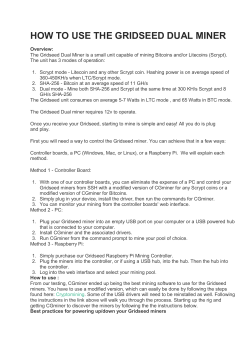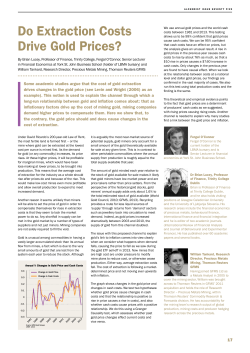
Backgrounder: Artisanal and SmallâScale Mining (ASM) in
Backgrounder: Artisanal and Small–Scale Mining (ASM) in Developing Countries Written by Dr. Marcello Veiga, Professor, Department of Mining Engineering at University of British Columbia; and Henrique Morais, Master, Industrial Social Psychology. Throughout the world, an estimated 30 million artisanal and small-‐scale miners extract about thirty mineral commodities using artisanal techniques in almost all developing countries. Gold is the dominant commodity mined by artisanal and small-‐scale miners. An estimated 10-‐ to 15-‐million people in over 70 countries are directly involved in the artisanal and small scale gold mining sector (ASGM), extracting 15%-‐20% of the world’s annual gold production. Artisanal and small–scale mining (ASM) defines the activity of small, medium, informal, legal and illegal miners who use rudimentary processes to extract minerals. Artisanal and small-‐scale mining is recognized by the World Bank as a mechanism of poverty alleviation in developing countries. ASGM plays an essential role in developing societies. Small mines can be a major source of revenue for rural communities, and can provide income for investment. Artisanal and small-‐scale miners can exploit a mineral deposit considered uneconomic by modern industry. However, artisanal mining, and ASGM in particular, is characterized by environmental degradation. Acid mine drainage, deforestation, soil erosion, river silting and the pollution of soil and water with toxic compounds are all consequences of ASGM. Health and social problems are also typical of ASGM communities. Primitive and low-‐cost technologies employed by miners lead to high occurrences of work-‐place hazard: fatal accidents are common. Exposure to toxic compounds leads to the unacceptable risk of carcinogenic exposure. Workers migrate from mine-‐site to mine-‐site creating friction, resentment and social instability. Gambling, prostitution and alcoholism are results of mining culture and increase the prevalence of sexually transmitted and communicable diseases in some parts of the world. Children are exploited for labour at many mining locations. If this mining sector is to have a sustainable future these negative consequences of artisanal mining must be addressed. Approximately 300 million people in over 70 countries depend on artisanal mining for their livelihood. The benefits and adverse impacts associated with artisanal mining are of global significance. These often involve elements of technological, economic, environmental, health and safety, social, and governmental and political concerns. Furthermore, the relationships and interactions between large companies and artisanal miners can be troublesome for both parties, and often lead to violence. Artisanal or Small-‐Scale Miners extract a broad range of materials including precious metals (gold, platinum and silver), gemstones (diamonds, sapphires, garnets, topaz, and emeralds), ores (copper, zinc, tin, tungsten and iron minerals), and industrial materials (limestone, granite, coal). Artisanal mining operations are typically reliant on simple but inefficient methods to mine and process ores. Miners usually lack the technology to explore and produce efficiently. Gold is the preferred target mineral of artisanal mining since the metal’s price has risen dramatically over the past decade. An estimated 10-‐ to 15-‐million people in over 70 countries are directly involved in the gold mining sector, and extract 15%-‐20% of the world’s annual gold production. It is common for artisanal miners, who work the claims informally, rather than the resource geologists representing the formal mining sector to initially unearth the gold deposits. Ironically, the attention given to potentially 4 0 8 , 6 1 9 0 A g r o n o m y R o a d V a n c o u v e r , B C C a n a d a V 6 T 1 Z 3 w w w . c i r d i . c a valuable geological targets by artisanal miners is not lost on the formal mining sector. The mining sector will often legally claim mining areas after artisanal miners have discovered them and then note that artisanal miners were mining illegally. This creates a paradox whereby millions of artisanal miners are currently considered trespassers working illegally upon mining concessions they initially discovered. The value of the socio-‐economic benefits of artisanal mining is immense in both scale and global extent. The opportunity exists to achieve harmony and synergy between regional governments, corporations of the established global mining industry, and the artisanal mining sector. Artisanal mining often provides the only means of income for rural communities and is therefore vitally important for livelihood. It is essential that efforts be made to maximize the benefits reaped by artisanal mining and to avoid or mitigate negative impacts. In many cases, the only perception of the mining industry that reaches the general public is of poor, disorganized and illegal artisanal miners (Veiga, 2009). Major mining companies, mining associations, ministries, and various aid organizations have the opportunity to address the challenges and engage positively to improve the conditions of these workers as part of their social responsibility programs. The relationship between large companies and artisanal miners is poorly understood and often troubled, with mutual mistrust and sometimes significant conflict. Large companies may consider artisanal miners to be trespassers, while artisanal miners may see the granting of a concession to a large company as depriving them of access to their land and livelihoods. Although examples of positive relationships are beginning to emerge, accusations are still made that governments and large mining companies, sometimes in alleged collusion, forcibly evict artisanal miners from their land. In other cases, political and business interests encourage migrant miners to move into an area being developed. These scenarios have led to resistance and resentment, and can result in serious conflicts. To some extent this is because miners and formal mining companies are competing for the same resources. Conflicts can occur in situations where it is difficult to assess the legality of occupation and claims to the land; ascertain which policies of resettlement or relocation have been applied; and/or whether rights have been violated or abused. This is partially attributable to the challenges artisanal miners face in articulating their views effectively to authorities or to world media. It is compounded by the difficulty that company officials, financial institutions, governments, NGOs and others have in establishing the facts of events occurring in distant mining regions. Companies are often ill equipped to build good relationships with artisanal miners. Large-‐scale, profitable operations can be at risk of failure, delays, and higher costs when local people have not been engaged in meaningful dialogue regarding the project activities and potential benefits. Difficulties are compounded by a lack of government presence or support for this part of the mining sector. In order to bridge artisanal mining with established mining companies, artisanal miners must be treated with consideration. A lack of awareness, particularly of the less viable or long-‐term environmental impacts of mining activities, combined with a lack of information about affordable methods to mitigate adverse impacts and a lack of obvious incentives to change practices, all contribute to this problem. In many cases governments do not attempt to control these activities, which fall outside the regulatory framework, or they lack the capacity to monitor or control these activities, as the activities often occur in remote and inaccessible locations, which compounds the problems. The activity of greatest concern is the use of mercury by gold miners releasing as much as 1500 tonnes per annum of Hg into the environment — or approximately one-‐third of total annual global mercury consumption. Currently, in an effort to increase recoveries, miners are misapplying cyanide by mixing it with mercury, creating an even more dangerous pollution. This has been observed in Brazil, Chile, Colombia, Ecuador, Backgrounder: Artisanal and Small–Scale Mining (ASM) in Developing Countries 2 Indonesia, Mozambique, Peru, Philippines, Venezuela and Zimbabwe where miners extract residual gold from Hg-‐contaminated tailings using cyanide, then release tailings into local water systems. The released mercury-‐cyanide compounds either bio-‐accumulate in the aquatic environment or transform into methyl mercury, the most toxic form of mercury (Castilhos et al., 2006, Sousa and Veiga, 2009, Velasquez et al., 2011) Artisanal miners often operate in hazardous working conditions. Major health risks associated with artisanal mining include exposure to dust (silicosis, mesothelioma); exposure to mercury, zing vapour, cyanide, acids, and other chemicals; and the effects of overexertion, inadequate workspace, and inappropriate equipment. Due to a lack of engineering expertise and capital, there are many accidents in artisanal mining caused by rock falls and subsidence, lack of ventilation, misuse of explosives, and obsolete and poorly maintained equipment — all of which lead to the death of approximately 10,000 artisanal miners annually. Health impacts are also felt in mining communities. Women and men who are directly or indirectly involved in mining frequently suffer health risks from exposure to mercury vapor, dust, cyanide, and/or zing vapour. For women these risks can be transferred to unborn children and to nursing infants who are exposed through breast milk. Children are particularly vulnerable: an estimated 1 million work in mines and quarries, risking their health, safety and future. Many of the children forced to work in mines are young females, as observed in some African countries. Cited as child labor in its worst form, young workers risk permanent injury from carrying heavy loads of rock, and contamination from nerve-‐ damaging mercury. Without the opportunity to attend school they are locked into a life of poverty. The health impacts of artisanal mining also include tropical diseases, sexually transmitted diseases and HIV. The temporary economic boom of an artisanal mining site attracts prostitutes and drug dealers whose activities exacerbate the dissemination of these diseases. Health effects also extend beyond the mines into surrounding communities. In general, those engaged in artisanal mining tend to lack adequate sanitation, with little access to clean water or basic health care in their communities. These problems are likely to be worse where miners have converged around a freshly discovered deposit or settled in unorganized camps. Such remote and temporary settlements are unlikely to have public health facilities — and apart from harboring diseases related to poor sanitation, they can also be breeding grounds from crime, prostitution and sexually transmitted diseases. Health care services may already be limited in remote regions and are often distant from mining sites. Access may worsen at certain times of the year due to challenging travel conditions. Many of the adverse social impacts facing artisanal-‐mining communities are similar to those associated with large-‐scale mining. The boom and bust cycle of the gold business creates economic problems for communities with repercussions on health. During bust times, mental health issues such as depression and anxiety have been reported in mining towns. Major changes in the social order that accompany transitions from agriculture to artisanal mining, especially in regions of inadequate subsistence lacking alternative sustainable economic activities, create substantial challenges. The local environmental damage caused by artisanal mining can also aggravate economic hardship, cause ill health, and disrupt previously existing farming activities. This can be partially linked to in-‐ migration: when large numbers of new people arrive, they come into conflict with local residents, sometimes provoking violence, while also introducing new social and health problems. When the gold rush ends and mining activities subside, local people may conclude that there are few lasting benefits. Most of the profits will have disappeared while social and environmental damages persist. For more information visit www.cirdi.ca Backgrounder: Artisanal and Small–Scale Mining (ASM) in Developing Countries 3
© Copyright 2025









